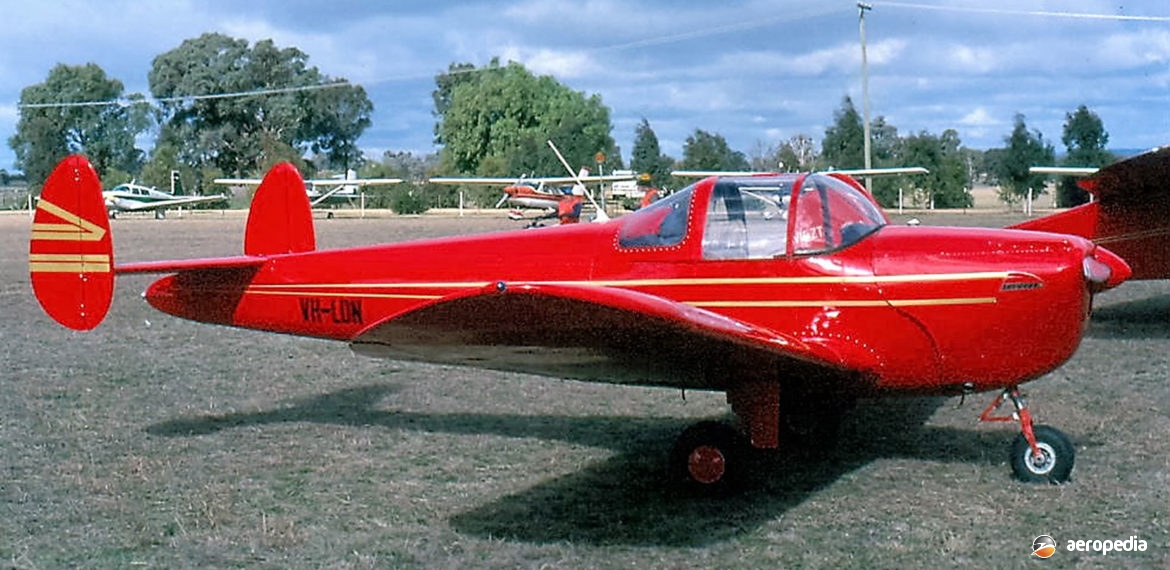Photograph:
Forney F-1 AirCoupe VH-LDN (c/n 5709) at Cowra, NSW (David C Eyre)
Country of origin:
United States of America
Description:
Two-seat light monoplane
Power Plant:
One 67 kw (90 hp) Continental C90-16F four-cylinder horizontally-opposed air-cooled engine
Specifications:
- Wingspan: 9.14 m (30 ft)
- Length: 6.15 m (20 ft 2 in)
- Height: 1.9 m (6 ft 3 in)
- Wing area: 13.25 m² (142.6 sq ft)
- Max speed at sea level: 208 km/h (129 mph)
- Cruising speed: 183 km/h (114 mph)
- Stalling speed: 90 km/h (56 mph)
- Initial rate of climb: 244 m/min (800 ft/min)
- Service ceiling: 4,725 m (15,500 ft)
- Range: 805 m (500 miles)
- Take-off run: 153 m (500 ft)
- Landing run: 183 m (600 ft)
- Empty weight: 408 kg (900 lb)
- Loaded weight: 658 kg (1,450 lb)
History:
The Ercoupe series of light two-seat monoplanes was designed to bring simplicity into flying. This was achieved by the elimination of rudder controls, so the handling of the aircraft was entirely co-ordinated through the control wheel, with the linked ailerons and rudder always applying a proper bank in a turn. This type of control system was said to make stalls and spins almost impossible.
The aircraft was designed by Fred E Weick, and the prototype was first flown in October 1937. Some testing was done with an engine named the Erco, designed by Harold Morehouse, but it was eventually decided to use the Continental series of four-cylinder units. Initial production aircraft, the Model 415-C, were fitted with a 48 kw (65 hp) Continental A65-8 engine, and had better than average performance for the power available. Type certification was obtained on 25 March 1940, and more than 100 had been manufactured when the American Government ordered a halt to production so that material could be used towards the war effort.
Following World War II, production resumed. Aircraft were fitted with the 56 kw (75 hp) Continental C-75-12 or C75-12F engine. The all-metal fuselage was of semi-monocoque construction in the forward section, and full monocoque aft. The cantilever wing, in two parts, was an all-metal mono-spar construction with diagonal wing ribs. The completed framework was covered in fabric.
Improvements were made to the design. The Model 415-D had an additional fuel tank and a complete electrical system. By 1946, 30 aircraft were being completed each day. In 1948 the Model 415-E appeared with a 63 kw (85 hp) engine, followed by the Model 415-F with a fuel-injected engine. Manufacture was then taken over by Sanders Aviation, which produced the Models 415-G and 415-H. Subsequently, production was taken over by Forney, and later by Alon.
Forney produced the type in 1955 as the F-1 AirCoupe. In 1960 production was taken over by Air Products which produced it as the Alon Air-Coupe F-1A. In the mid sixties it was being marketed as the AirCoupe 415-D Club Trainer. In 1968 Mooney Aircraft purchased manufacturing rights, changed the tail to a single unit, and sold the type as the Mooney Cadet. Two models were produced, the A-2 Cadet and the M-10 Cadet. Production continued until 1970.
Two Ercoupes remain extant in New Zealand, one being Model 415-C-1 (c/n 4780 – ex OO-EXC, NC94669) which became ZK-AQX. This aircraft was flown from Antwerp i n Belgium to Auckland, NZ arriving on 19 October 1947, covering 19,000 km (11,806 miles) in 22 days, for a period holding the record for the world’s longest low-powered flight with a Continental engine of 56 kw (75 hp). A 181 litre (39 Imp gal) tank was installed on the passenger’s seat for the journey, and the aircraft was fitted with a variable pitch propeller. The total fuel gave an endurance of 15 hours. Whilst owned by the Auckland Aero Club the engine was replaced with a 67 kw (90 hp) version. It was badly damaged when it hit a fence at Mangere on 15 April 1951 and had to be rebuilt.
A further example which became ZK-EXC (c/n 4811 – ex N94700) was registered in March 1994 and has been noted at Tauranga.
A number of examples have been imported to Australia. One was imported in 1959 but was never registered and was used for apprentice training at the Sydney Technical College at Ultimo, NSW and also at Tamworth, NSW. It was later taken to Wagga Wagga, NSW. This machine was built by Forney.
Australian registered examples have included VH-LDN (c/n 5709), a Forney F-1, and VH-ERC (c/n 1345), a Model 415-D. At least two have been registered under Recreational Aviation Australia (RAA) Regulations, including 32-5501 [probably incorrectly registered as a powered chute on 6 March 2009] and Model 415-C 24-3491 (c/n 246 – ex N87073, NC87073) registered on 5 February 2001.
Another Model 415-C (c/n 3090 – ex N2465H), built in 1946 and fitted with a Continental C85-12 engine, was under restoration in Melbourne, VIC but in mid 2014 was placed on the market for sale.

